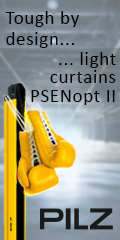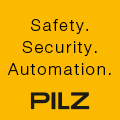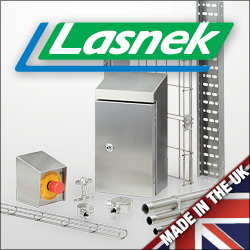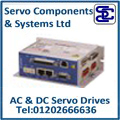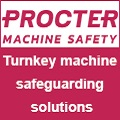
Posted to News on 27th Jan 2020, 10:21
KEB drives, controllers, HMIs used by Concrete Canvas Ltd
By installing servo drives with integrated functional safety, HMIs and controllers from KEB Automation on its new production line, Concrete Canvas Ltd has reduced wiring installation costs and is benefiting from greater flexibility in terms of future expansion plans for machines and additional lines.
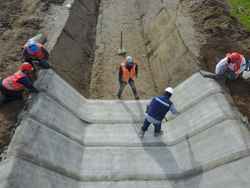
Based in Pontyclun, Wales, Concrete Canvas Ltd is the sole manufacturer of the award-winning products Concrete Canvas (CC) and CC Hydro (CCH), which are manufactured in South Wales and exported to more than 80 countries. CC is a new material technology called a geosynthetic cementitious composite mat, or GCCM. The material is a flexible concrete-impregnated fabric that hardens on hydration to form a thin, durable, waterproof concrete layer. Essentially, the product is 'concrete on a roll.' CC can be installed using simple hand tools, with no requirement for specialist labour or equipment, and can be installed up to 10 times faster than conventional methods.
In Spring 2018, due to increased demand for its products, Concrete Canvas Ltd purchased a new facility in Pontyclun, around six miles from the original factory in Pontypridd. This new site is around three times the size of the Pontypridd facility, providing the company with significant opportunities for continued growth.
Graham Rose, Engineering Manager at Concrete Canvas Ltd, is responsible for developing the new production lines at Pontyclun, including machinery, controls and automation systems. He states: "As there was no off-the-shelf machinery available for producing our new product, all the design and build work was performed in-house."
The continuous production line for the new prototype rolled product comprises a variety of machines, equipment and automated systems, including unwinders, dry cement powder handling systems, a main process section that forms the cement filled web, coating machines, web handling machines and rewinders.
He continues: "The prototype production line is quite complex. There are many different machines with parts that need to be moved at different speeds. We therefore started to search for a suitable supplier of drives that could handle this type of application. We needed the drives to be flexible and easily expandable to allow easy, rapid future expansion of the line and individual machines, with as little panel wiring as possible. Another key requirement for us was safety, so we wanted drives with in-built functional safety."
Common development platform
After a thorough supplier evaluation process, which included on-site demonstrations, Graham chose KEB Automation for its servo drives with FSoE (FailSafe-over-EtherCAT), as well as HMIs, a smart controller and the COMBIVIS 6 software that provides a common development platform.
Graham adds: "At present, we have around 10 COMBIVERT S6-A servo drives and some F6 drives from KEB operating on the production line. The lower powered drives tend to perform lighter duties such as transporting the web material, whereas the larger drives control the conveyors and mixers for the cement, the main web forming process section and the centre winding machine, as well as performing general positional and control tasks. Some of the drives are linked so that they operate synchronously, which is critical when controlling line speed set points and the intricate, varying tensions of the web material."

Graham says: "We use a variety of electric motors on the line including synchronous and asynchronous induction motors, permanent magnet motors and servo motors. The S6 drives are so flexible that they can drive any type of motor, with or without encoders, so this was never an issue for us."
The S6-A drive is a flexible, modular design that allows scaleable functional safety, from basic STO (Safe Torque Off) to encoder-based safe motion. Optional use of current speed-based safety functions (eg Safe Limited Speed, Safe Maximum Speed, Safe Operating Stop, and Safe Direction) is available. All safety functions can be used in applications up to IEC 62061 SIL3 in accordance with IEC 61508 or up to PLe in accordance with ISO 13849. The safety functions are controlled via secure digital inputs or via FSoE. The S6-A also provides more real time fieldbus control options and safety PLC communications (EtherCAT, Profinet, Powerlink), giving Concrete Canvas a genuine future-proof, Industry 4.0/IoT-capable servo drive.
Graham explains: "In terms of safety, we need some of the drives to be capable of braking or ramping down at controlled rates, so we are already using some of the drive safety functions. In the future, as the line expands, we will use a lot more, as we will need to introduce more safety systems to the line, including safety gates, light curtains and safe interlock switches. With KEB drives, we can support this expansion quickly and easily using the KEB COMBIVIS 6 development software platform."
Start up and analysis software
COMBIVIS 6 enables start up, administration and analysis of KEB drives. This includes start-up Wizards for quick and easy product configuration, direct access to device documentation, as well as enabling online drive parameter list comparisons and the set up of key safety indicators and functions. With a foundation built on libraries, devices and template databases, COMBIVIS 6 allows rapid, simple solutions to be generated for a wide range of applications.

Graham says: "Our environment here is digital fieldbus and EtherCAT, so in the future I can add safety and functionality to the machines easily and quickly, with reduced panel wiring. The COMBIVIS 6 software is critical here, as it allows us to quickly add new safety features to the drives and gives our engineers a common platform for the development environment."
The new prototype production line has been up and running for almost a year now and Graham is delighted with the results: "By installing servo drives with integrated functional safety, we have reduced the wiring, so our installation costs in terms of materials (eg reduced number of safety relays) and time have been minimised. We also have greater flexibility in terms of future expansion of the line. Any changes or additions can be made using software rather than installing new hardware. We can control the motors with or without encoders using the same drive, giving us even greater options, flexibility and cost savings. We are also about to introduce a new machine with Siemens S7 PLCs. KEB has provided us with a software module that allows data to be exchanged between this and our other controllers."
He concludes: "We have been very impressed with KEB in terms of their technical capabilities and support over the last 12 months. They have been very helpful and have responded quickly when we have needed support on resolving any issues. I was also impressed by the excellent price-performance ratio of the KEB S6 drives compared to other drive suppliers on the market. I look forward to working with KEB in the future as our production line expands."
For more information, go to www.keb.co.uk.




